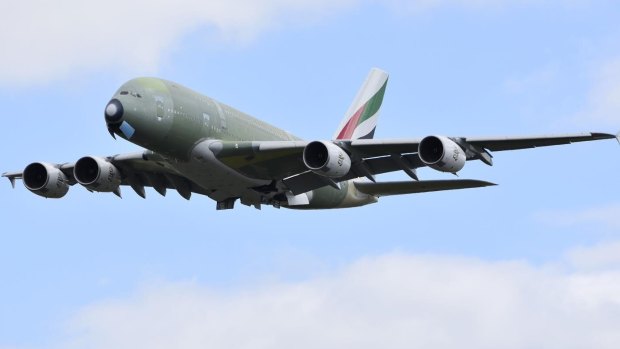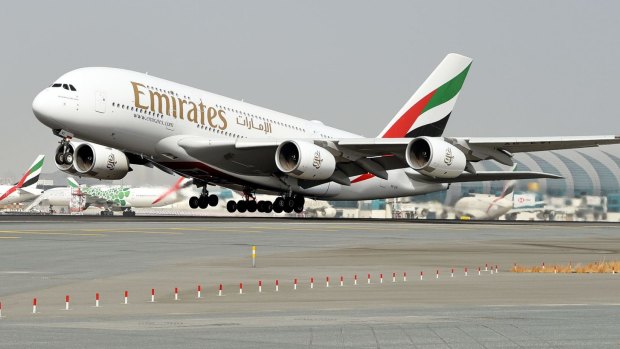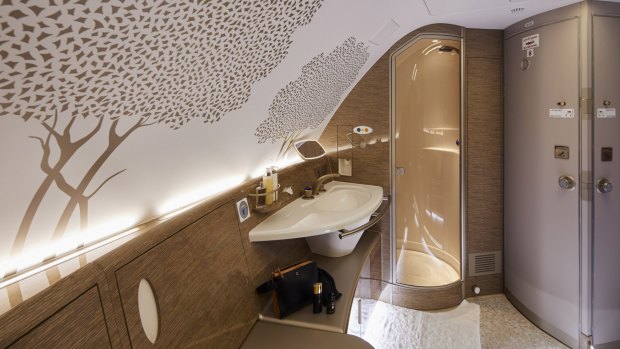This was published 3 years ago
Airbus A380: The last superjumbo takes off on its first flight
By Craig Platt

The final Airbus A380 takes off from the company's headquarters in Toulouse, France.Credit: AIRBUS
The final Airbus A380 superjumbo has taken to the skies for the first time, departing from the company's Toulouse, France, headquarters on Thursday.
The plane flew to Hamburg, Germany, where it will be painted in the livery of its owner, Emirates, before being delivered to the airline.
Airbus CEO Guillaume Faury congratulated his team for their work on the superjumbo, tweeting: "Well done #TeamAirbus for your contributions over the years - looking forward to supporting this iconic aircraft & its customers for many years, delivering best-in-class passenger experience".

Emirates is the largest customer for the superjumbo, with more than 100 A380s in its fleet.Credit: Supplied
The plane, registration A6-EVS, will join Emirates' existing fleet of 117 A380s, the largest superjumbo fleet in the world.
The airline reportedly tried to cancel its remaining order for the A380 last year after the COVID-19 pandemic caused a huge downturn in air travel, but Airbus objected as the planes were already under construction. Emirates took delivery of three new superjumbos in December.
Despite the decline in the aircraft's popularity, Emirates president Sir Tim Clark said the A380 has been a success story for the airline.

Emirates used the size of the A380 to create the world's first bathroom with a shower on board for first-class passengers.Credit:
"The A380 has helped us efficiently serve customer demand at slot constrained airports and also on trunk routes, supporting our long-haul hub operations. Importantly, with the space and technology on this aircraft, we've been able to introduce new concepts onboard that have transformed the flying experience for the better," he said.
The departure of the last ever A380 from its manufacturer's base marks the end of an era for the superjumbo, the largest passenger aircraft of all time.
The plane launched to massive fanfare in 2007 with its first customer Singapore Airlines. Its first commercial flight was from Singapore to Sydney on October 25 that year.
The A380 was a revelation in air travel - capable of carrying more than 500 passengers in a typical three-class layout, with certification for up to 853 passengers in an all-economy layout (something that some airlines raised the prospect of, but never implemented).
Airlines such as Singapore Airlines, Emirates and Etihad used the size of the superjumbo to create never-before-seen luxuries on board for passengers in the pointy end. Singapore Airlines introduced private suites for its first-class passengers, including seats that converted into double beds. Emirates provided a shower in its first-class bathroom, while Etihad created "The Residence" - a three-room suite at the front of first class, featuring a lounge, bedroom and private bathroom, complete with personal butler service.
But despite these impressive features and great popularity with passengers, sales slumped as early as 2013, with Airbus failing to receive a single firm order for the plane that year.
Only six years later, as smaller and more fuel-efficient planes like the Boeing 787 Dreamliner and the Airbus A350 became more cost-effective options for airlines, Airbus announced it would halt production of the superjumbo.
In 2019, the first A380 ever built moved to an aircraft storage facility in France. It has since been dismantled for parts and scrap.
The advent of the COVID-19 pandemic has seen most airlines with superjumbos ground the large aircraft, as demand for air travel has plummeted. Qantas chief executive Alan Joyce said Qantas' fleet of 12 A380s would be grounded for three years, until international travel recovers. The planes are currently being stored at an aircraft "boneyard" in California.
The rise and fall of the A380 seems particularly rapid since its key rival, the Boeing 747 jumbo jet, has enjoyed more than 50 years as the workhorse of long-haul travel.
But the 747 has fallen victim to the same pressures as the A380, with most airlines - including Qantas - retiring their jumbo jets. The latest model, the 747-8, sold to just a few carriers.
In July last year, Bloomberg reported that the 747, which Boeing has continued building due to demand for the freighter version, is likely to cease production in two years.
See also: Tears and tributes as the last Qantas 747 departs Australia for final time
See also: 'COVID-19 has terminated my career': Hero of A380 flight QF32 grounded
Sign up for the Traveller newsletter
The latest travel news, tips and inspiration delivered to your inbox. Sign up now.